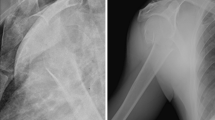Abstract.
The humeral head fracture in the elderly represents an unresolved problem, which is reflected by the variety of existing therapeutic strategies ranging from conservative treatment to humeral head replacement. The main factors influencing the prognostic outcome are the fracture type, age of the patient and biologic criteria such as osteoporosis, blood supply at the fragments, and the degree of soft tissue trauma. For selection of the optimal treatment, the general condition of the patient, additional injuries and chronic diseases have to be respected as much as the patient's compliance and personal demands. According to experimental and clinical findings, for displaced two- and three-part fractures of the elderly patient minimal osteosynthesis and in the future plate osteosynthesis with angular stability should be preferred. For these fracture types, conservative treatment must be included in the therapeutic spectrum. In contrast, displaced four-part fractures and fracture dislocations are indications for primary humeral head replacement. This is explained by the fact that neither conservative treatment nor surgical reconstruction procedures meet the main goal of primary therapy, aiming for early painless mobilization and for timely discharging the elderly patients in their social environment.
Zusammenfassung.
Die Humeruskopffraktur des alten Menschen stellt ein ungelöstes Problem dar, was sich in dem breiten Therapiespektrum, von der konservativen Behandlung bis zum prothetischen Ersatz des Humeruskopfs, wiederspiegelt. Neben dem Frakturtyp und dem Alter des Patienten sind biologische Aspekte wie die Osteoporose, die Durchblutung der Fragmente aber auch die Weichteiltraumatisierung von entscheidender prognostischer Bedeutung. Bei dem Behandlungskonzept muss weiterhin die Gesamtsituation des Patienten, das Vorliegen von Begleitverletzungen oder -erkrankungen, die Compliance und der Anspruch des Patienten mitberücksichtigt werden. Nach experimentellen und klinischen Erkenntnissen sind bei den dislozierten 2- und 3-Segmentfrakturen des alten Menschen die Minimalosteosynthesen und zukünftig die winkelstabilen Plattensysteme zu favorisieren. Die konservative Behandlung muss bei diesen Frakturtypen mit in therapeutische Überlegungen einbezogen werden. Die dislozierten 4-Segmentfrakturen und Luxationsfrakturen stellen dagegen eine Indikation zum primären endoprothetischen Humeruskopfersatz dar, da weder die konservative noch die operativ rekonstruierende Therapie dem primären Behandlungsziel beim alten Menschen, der raschen schmerzfreien Mobilisierung und Entlassung in die häusliche Umgebung, ausreichend Rechnung tragen.
Similar content being viewed by others
Author information
Authors and Affiliations
Rights and permissions
About this article
Cite this article
Lill, H., Josten, C. Konservative oder operative Versorgung der Humeruskopffraktur beim alten Menschen?. Chirurg 72, 1224–1234 (2001). https://doi.org/10.1007/s001040170025
Issue Date:
DOI: https://doi.org/10.1007/s001040170025




